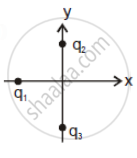Advertisements
Advertisements
प्रश्न
Two particles A and B with charges q and 2q, respectively, are placed on a smooth table with a separation d. A third particle C is to be clamped on the table in such a way that the particles A and B remain at rest on the table under electrical forces. What should be the charge on C and where should it be clamped?
उत्तर
For equilibrium,


\[\text{Again }, \vec{F}_{AC} = \vec{F}_{CB} \]
\[\text{So} , \frac{1}{x^2} = \frac{2}{\left( d - x \right)^2}\]
\[\text{Or 2 x}^2 = \left( d - x \right)^2 \]
\[ \text{Or }\sqrt{2}x = d - x\]
\[ \text{Or x } = (\sqrt{2} - 1)d\]
For a charge at rest,
\[\vec{F}_{AC} = \vec{F}_{CB} \]
\[\frac{1}{4\pi \in_0}\frac{q\theta}{[(\sqrt{2} - 1)d ]^2} + \frac{1}{4\pi \in_0}\frac{q \times 2q}{d^2}\]
\[ = 0\]
\[ \text{ Or } \theta = (6 - 4\sqrt{2})q\]
APPEARS IN
संबंधित प्रश्न
A polythene piece rubbed with wool is found to have a negative charge of 3 × 10−7 C.
(a) Estimate the number of electrons transferred (from which to which?)
(b) Is there a transfer of mass from wool to polythene?
A conducting sphere of radius 10 cm has an unknown charge. If the electric field 20 cm from the centre of the sphere is 1.5 × 103 N/C and points radially inward, what is the net charge on the sphere?
A point charge is brought inside an electric field. The electric field at a nearby point
(a) will increase if the charge is positive
(b) will decrease if the charge is negative
(c) may increase if the charge is positive
(d) may decrease if the charge is negative
Two particles A and B, each with a charge Q, are placed a distance d apart. Where should a particle of charge q be placed on the perpendicular bisector of AB, so that it experiences maximum force? What is the magnitude of this maximum force?
A positive charge q is placed in front of a conducting solid cube at a distance d from its centre. Find the electric field at the centre of the cube to the charges appearing on its surface.
Choose the correct option.
Two point charges of +5 μC are so placed that they experience a force of 8.0 × 10-3N. They are then moved apart so that the force is now 2.0 × 10-3N. The distance between them is now
Two small spheres 18 cm apart have equal negative charges and repel each other with the force of 6 × 10-3 N. Find the total charge on both spheres.
When 1019 electrons are removed from a neutral metal plate through some process, the electric charge on it is ______
A conducting sphere of radius 0.104 m has an unknown charge. If the electric field at 0.20 m from the centre of the sphere is 1.5 x 103 NC-1 and points radially inward, what is the electric flux?
Ionization of a neutral atom is the ______.
Conductors are materials that allow ______.
In figure two positive charges q2 and q3 fixed along the y-axis, exert a net electric force in the + x-direction on a charge q1 fixed along the x-axis. If a positive charge Q is added at (x, 0), the force on q1 ______.
(1) |
(2) |
Electric charge is uniformly distributed along a long straight wire of radius 1 mm. The charge per cm length of the wire is Q coulomb. Another cylindrical surface of radius 50 cm and length 1 m symmetrically enclose the wire as shown in the figure. The total electric flux passing through the cylindrical surface is ______.

Electric field lines provide information about ______.
Which one of the following is the unit of electric charge?
A positive charge particle of 100 mg is thrown in opposite direction to a uniform electric field of strength 1 × 105 NC–1. If the charge on the particle is 40 μC and the initial velocity is 200 ms-1, how much distance it will travel before coming to the rest momentarily ______.
Given below are two statements:
- Statement I: The electric force changes the speed of the charged particle and hence changes its kinetic energy; whereas the magnetic force does not change the kinetic energy of the charged particle.
- Statement II: The electric force accelerates the positively charged particle perpendicular to the direction of the electric field. The magnetic force accelerates the moving charged particle along the direction of the magnetic field.
In light of the above statements, choose the most appropriate answer from the options given below.
